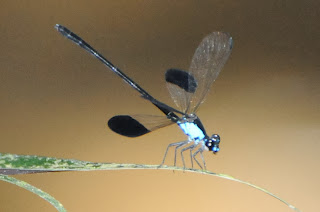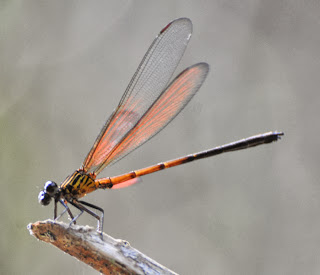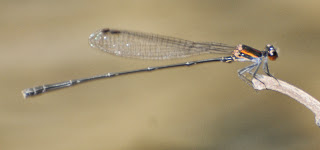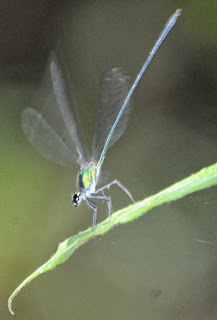The river that marked the western border of Taman Negara proved (during my September 2012 visit) to be an excellent venue for watching (and trying to identify) damselflies. Here is a gallery, starting with one, photographed on the bridge leading to the entranceway, that I am having trouble identifying. I think it is a member of the genus Archibasis, but I am far from sure. A. rebeccae has been recorded in the park, but seems to have broader, deeper-blue shoulder stripes than this individual. If it is an Archibasis it may be A. incisura.
Some teneral (ie newly-emerged) male damselflies are very pale - a so-called "ghost phase" - compared to the way they will look later in life. This Copera marginipes is an example (sorry about the blur!).
Dysphaea dimidiata, a member of the Euphaeidae, looks more like some sort of dragonfly than a damselfly. It is large and robust, and tends to perch, dragonfly-like, with its wings open, catching a patch of sun over the waters of the river.
I found two members of the genus Euphaea itself (with Dysphaea making up the three Euphaeid species in peninsular Malaysia), both among the most attractive and easily-recognizable of damselflies. This is Euphaea impar.
Even more beautiful, to my eye, is Euphaea ochracea, with its richly copper-tinged wings.
Members of the Chlorocyphidae are easily recognized by their short, stout abdomens - as far as I know they are the only damselflies in which the abdomen is shorter than the folded wings. This one is Heliocypha perforata.
Besides perching on rocks or twigs, H.perforata frequently hovered over the river surface - presumably an aggressive display, as sometimes two individuals would hover head to head (the equivalent of getting in each other's face?).
In Prodasineura humeralis, by contrast, the abdomen is particularly elongate and slender. This is a member of the family Protoneuridae.
Crossing the bridge over the river at night, I found many Vestalis damselflies roosting on the tips of leaves overhanging the water.
I have seen these elegant and beautiful insects many times, but they never fail to impress me - they are, to me, the aristocrats of the damselfly world.





















No comments:
Post a Comment